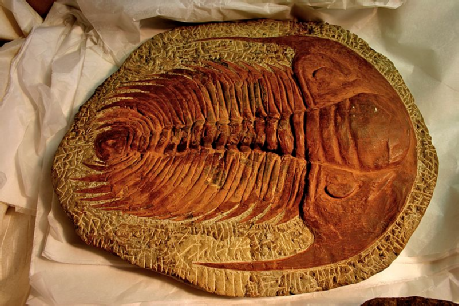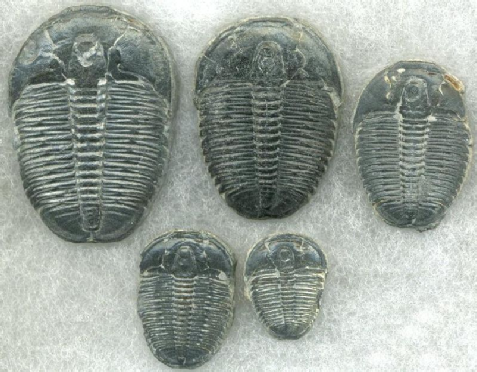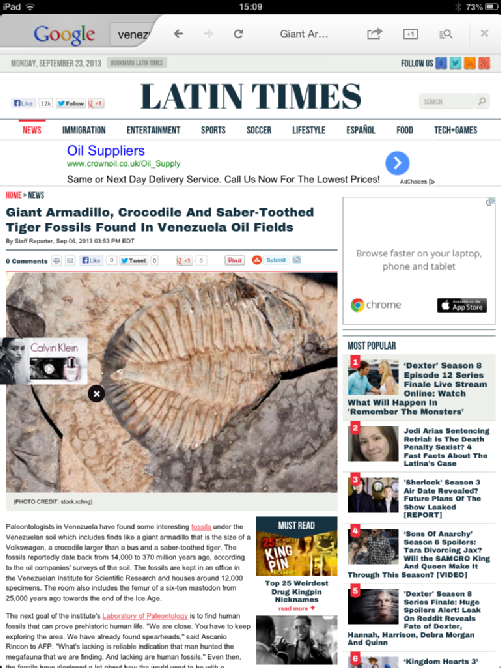Can evolutionary theory be falsified?
It is generally accepted that a scientific theory must be potentially falsifiable. If it were not capable of being proved wrong it would take on a pseudo religious aspect; because religions cannot be proved to be wrong, which is probably why they can endure through millennia however absurd they may appear to the modern world. Neo-Darwinism has been accused of failing this test. If this were established then it would not meet the criteria required of a bona fide scientific theory. This serious accusation was met almost jokingly by J.S Haldane. He famously remarked that if a rabbit fossil were ever found in pre-Cambrian rocks then evolutionary theory would be falsified. Richard Dawkins has used the same reference to make the same point. He said that the discovery of fossil mammals in Precambrian rocks would "completely blow evolution out of the water."
This example is used because there is no way according to the evolutionary mindset that a rabbit could ever be found in rock layers dated 400,000000 to 500,000000 years ago. The challenge attributed to Haldane's and Dawkins is made because they know for a "fact" that a modern mammal could not possibly appear in the lowest rock layers of the geological column: the Pre-Cambrian and Cambrian.
Haldane was born into an era that expected very primitive fossils to be found in the pre-Cambrian: the lowest level of rock strata found on earth. By the time he died in 1964 there still remained the hope that some Pre-Cambrian fossil intermediates would be dug up and endorse Darwin's nineteenth century expectations. In fact nothing of much substance has been discovered in this layer of rock formations; it is in strata immediately above, the Cambrian, that varied forms of complex multi-cellular life made their first appearance. A rabbit fossil found in the Cambrian would be a sensational find, and one which would thoroughly discomfort ardent evolutionists. Up to the present time no such event has occurred. So as there are no fossils of anything remotely like a multicellular organism in the Pre Cambrian rocks it is more realistic to test Haldane's challenge by looking at geologically ancient strata which are full of fossils: anything from reasonably close to the Cambrian.
Is it possible to reverse Haldane's challenge and pull a rabbit out of a hat?
There is an example that might qualify: judge for yourself. This is story about something turning up in the most unexpected place; like finding Barrack and Michelle Obama waiting with a trolley-load of economy brands at a checkout queue in your local Asda supermarket.
Like many good stories this one begins quietly enough. The following accounts introduce the subject.
An ancient tar pit exposed when Venezuelan oil workers laid a pipeline has yielded a rich trove of fossils, including a type of sabre-toothed cat that paleontologists had never found before in South America. Scientists say the find holds the promise of many discoveries to come.
The fossils are 1.8 million years old and include skulls and jawbones of six scimitar-toothed cats - a variety of sabre-toothed cat with shorter, narrower canine teeth than other species.
Researchers led by Venezuelan paleontologist Ascanio Rincon announced the discovery.....saying in addition to proving the cat once lived here, the find also should offer a rare window into the environment shortly after North and South America became connected following an age of separation.
"The deposit could be one of the most important in South America in the last 60 years," Rincon told The Associated Press.
Other experts agree.
"The find is one of the most spectacular and scientifically interesting discoveries of the last decade," said University of Kansas professor Larry D. Martin, an expert on sabre-toothed cats who was not involved in the find. "The genus hadn't been known from South America before."
The state oil company set aside the site for research in 2006 and contacted Rincon at the Venezuelan Institute for Scientific Studies. After months of digging, he and his team found the prized fossils in April 2007.'
Fabiola Sanchez / The Associated Press / Aug 2008
These finds and the many others that have have followed are all attributed to the Pleistocene, a period that ushers geology and palaeontology into the modern era: from 2.6 million years up to the present.
There are a number of references to this Venezuelan fossil find on the Internet, mostly from a variety of periodicals and newspapers including the Daily Mail and Guardian. But National Geographic is probably the most significant and prestigious of these magazines and newspapers. They were happy enough to write about this discovery when everything seemed to be in good order. The first fossils catalogued were as stated, sabre-toothed cats and these were consistent with expectations. They are animals that fall comfortably within the dates given for the Pleistocene era. National Geographic have however made no further reference to this find since their initial interest was expressed, at least, not that I can find. This could be because either a fossil or a number of fossils have been found in this tar deposit that do not fit. Something truly sensational, since in all recent reports the dates when given for these Venezuelan fossils have been adjusted to indicate geological eras separated by vast tracts of time.
To prove this we move on to very recent accounts from 2013.
The following quote is from the Latin Times.
'Paleontologists in Venezuela have found some interesting fossils under the Venezuelan soil which includes finds like a giant armadillo that is the size of a Volkswagen, a crocodile larger than a bus and a sabre-toothed tiger. The fossils reportedly date back from 14,000 to 370 million years ago, according to the oil companies' surveys of the soil....'
The Latin times features a headline beneath which is a large photo of one of the few creatures that could explain these dates. A deep sea creature that could never naturally be associated with sabre-toothed tigers or armadillos. It is a trilobite: one of the first complex organisms on earth according to evolutionary theory.
Below are a selection of trilobites from Wikipedia Commons. They are as you can see as good as identical to the one depicted in the Latin Times.
One depicted
14 THOUSAND TO 370 MILLION YEARS IS SIMPLY IMPOSSIBLE!
Evolutionary theory cannot accommodate such a range of dates from a single deposit. Dates that pass over entire geological eras. Animals from the Devonian, dated at between 416-359 million years are supposed to have seen the arrival of the tetrapods, the first four limbed vertebrates. These creatures are so far removed from mastodons and armadillos etc that even the thought of linking them together would send any competent paleontologist into a tailspin. It is inconceivable that a creature from this remote period, hundreds of millions of years ago, could be found nestling up against a sabre toothed cat and a human artifacts like a spear-heads which have also been found.
A trilobite is one of few fossil finds that could explain these impossibly far flung dates. Nothing I have seen on the Internet has described the recent fossils finds in any detail. But one thing is sure; something very strange has turned up in this tar pit.
he only photo released to the media by paleontologist Ascanio Rincon that is characteristic of a fossil associated with dates like 370 million years looks exactly like a trilobite. These can range from anywhere between 542 million years and 250 million when they suddenly became extinct. All this of course presumes evolutionary dating methods are accurate.
In another web magazine, artdaily.org dated 21st September 2013 there is a banner headline that reads:
Out of the oil emerges Venezuela’s "Jurassic Park" Fossils 14,000 to 370 million years old.'
The web link to this page is: / artdaily.com/.../Out-of-the-oil-emerges-Venezuela-s--Jurassic-Park---Fossils...
Beneath that there is photo of a fossil which I cannot reproduce for copyright reasons. It is labelled as a “fish fossil in Venezuela”. I believe that is wrong since it is clearly not a fish fossil, but it does look remarkably similar to another type of trilobite, an example of which is seen below.

This photo was originally uploaded at http://www.britainloveswikipedia.org /Author: Mike Peel
Trilobites are icons of the Cambrian era: a rock strata which does take you right back at least 370 million years according to the long age evolutionary hypothesis.
There is another source that displays the Venezuelan tar pit fish / trilobite. It can be seen on this link: Daily Mail www.dailymail.co.uk/.../Armadillos-big-cars-crocodiles-bigger-buses-ton..
The photo in the Mail of what appears to be a fossilised trilobite is the second to last of a number of fossils shown in descending order. The photo you need to look at is titled: A fish fossil. I ask you to examine either of these Internet links and compare the image of the supposed fish to that of a fossilised trilobite seen above. In body shape they are identical. Look for a fish fossil image and see if you can find anything that looks even close to the one that appears alongside any of Rincon’s other fossils.
To my knowledge there has never been any explanation for the 370 million year date. There appears to have been not only no explanation for the impossible gap between the two possible dates but no news of any kind since that date was announced. Why? A reason could be that since the reports from September 2013 all further information has been suppressed. This matter must be embarrassing to evolutionists and potentially threatening to the credibility of evolutionary theory. The question remains, was there a fossilised trilobite buried in this tar pit, and if there was does it prove that the Theory of Evolution actually is falsifiable?
What we have here is the possibility of the Haldane / Dawkins challenge being met and trumped.
In a deposit clearly dated by paleontologists as Pleistocene, there has turned up what would be the equivalent of a rabbit fossil in the Cambrian. A trilobite, a creature that finally became extinct 250 million years ago turning up in the Pleistocene, an era which began only 2.6 million years ago.
Taking the best case scenario for Haldane, Dawkins and Co. This represents a gap of 247.4 million years.
These tar deposits: ' Also known as oil sands or tar sands are sediments or sedimentary rocks composed of sand, clay minerals, water and bitumen. The oil is in the form of bitumen, a very heavy liquid or sticky black solid with a low melting temperature. Bitumen typically makes up about 5 to 15% of a deposit. The method used to extract bitumen from an oil sand depends upon how deeply the oil sand is buried. If the oil sand is deeply buried wells must be drilled to extract the bitumen. If the oil sand is close to the surface it will be mined and hauled to a processing plant for extraction.'
Information from the website Geology.com.
Rincon’s discovery was found close to the surface.
How could a trilobite or any other Cambrian or Devonian animal find itself in a tar deposit dated as being laid down less than 2.6 million years ago? Well, one thing is for sure, there is no way a slow and gradual process could have done it. Whatever it was, it must have been catastrophic, and as it has been found fossilised in a mass graveyard with a great variety of other creatures it must have been deposited by some massive turbulent water borne sedimentary current. The Bible and only the Bible could provide the answer to this conundrum. A global flood associated with huge tectonic upheavals could easily account for such a strange event. How else could any deep sea creature be swept up to near the surface other than by turbulent and perhaps colliding turbidity currents? These could create a vortex that swept or sucked up a trilobite in a one in a few million chance event; an event that deposited it in a mix of flora and fauna which ended up forming this Venezuelan tar pit. A huge flood-water or turbidity current associated with tectonic upheavals is a scenario could that could explain this fossilised and thoroughly mixed group of flora and fauna. It could also explain how and why they were deposited together far from their original habitats.
If this extraordinary date of 370 million years is officially confirmed in a full public statement by Rincon et al at the Venezuelan Institute for Scientific Studies then what are the evolutionists going to say by way of explanation. If this remains unnoticed by mainline creationist groups it will no doubt be ignored. If it does get out then they will surely find some way, they must, since their theory depends on long time scales. The evolutionist response, which will be too explain away the entire matter, will prove that the Haldane / Dawkins test would fail to falsify the theory of Evolution.
The truth is nothing will do that; this theory is not scientifically falsifiable because no evidence however compelling will be permitted to bring it down. It is simply impervious to criticism. Any discovery however apparently dire will just be incorporated into the theory, maybe under another sub heading, but it will be included. Darwinism will only fall when the many good, decent, honest scientists, who I am convinced are in the majority, get sick and tired of upholding a version of events that becomes an embarrassment to them. Darwinism is a state sponsored myth, weak, false and vulnerable. But like many other philosophical and political ideas it will flourish until it runs out of credibility, its ruling elite falters and its enforcers lose faith.















